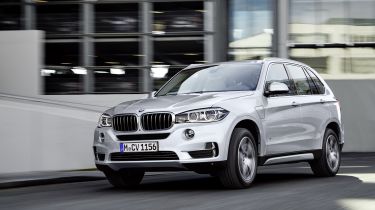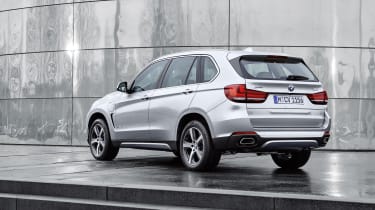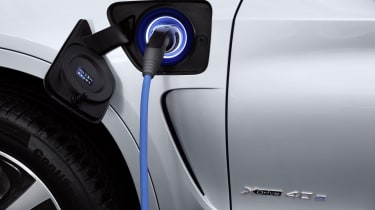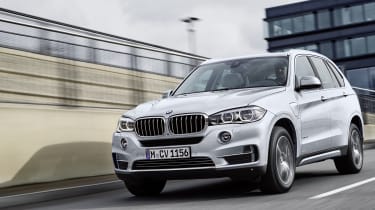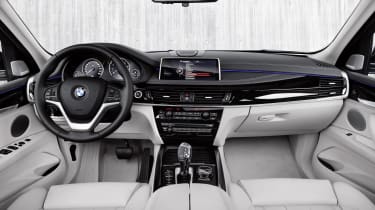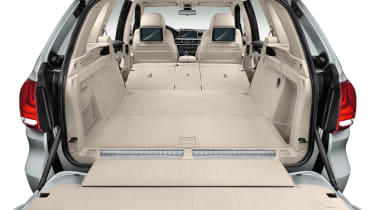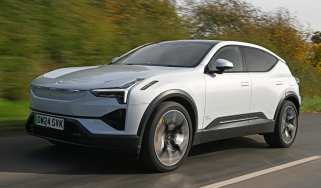BMW X5 xDrive40e (2014-2018)
“The BMW X5 plug-in hybrid is ideally suited to company-car buyers after a large SUV”
Pros
- Low company-car tax
- Cheapest non-diesel X5
- Great handling for an SUV
Cons
- Expensive optional extras
- Four-cylinder engine noise
- Diesel better suited to motorways
The BMW X5 has figured high in the list of premium SUVs ever since the first generation appeared almost two decades ago. However, while it’s an excellent car in many ways, its big, powerful petrol and diesel engines combined with that hefty body mean running costs are steep across the range.
For that reason, BMW offers an X5 with the same emissions-cutting plug-in hybrid technology available in every BMW saloon from the 3 Series to the 7 Series. It joins the Mercedes GLE 500e, Volvo XC90 T8 Twin Engine, Audi Q7 e-tron and Porsche Cayenne S E-Hybrid in an expanding market niche for low-emissions luxury SUVs.
Like other BMW iPerformance models, the big draw for the X5 40e plug-in hybrid is that it has a lower Benefit-in-Kind (BiK) company-car tax rating than other SUVs. This comes thanks to official CO2 emissions of 77g/km, placing it in the 17% BiK bracket. By comparison, the lowest bracket for a diesel X5 is 29% and other SUVs face even steeper tax ratings.
The 40e is also by far the least expensive petrol car in the X5 range, undercutting the xDrive50i by around £9,000. You can buy a diesel X5 for less, though, and if you’re not in a position to benefit from the 40e’s attractive company-car tax rates, an X5 sDrive25d may work out more cost-effective, particularly if you make a lot of long journeys.
More reviews
That’s because the 40e’s claimed fuel economy of up to 85.6mpg is most likely to be achieved on short, urban journeys, where the electric power system comes into play. On motorway journeys, it’s possible that the 40e will use more fuel than the 53.3mpg diesel.
The electric motor does have other benefits, though: it gives the X5 a more muscular feel than with the 2.0-litre petrol engine alone. Although the four-cylinder engine generates 242bhp, that’s not a huge amount of power for a big, heavy car. However, the electric motor contributes another 111bhp to allow a 6.8-second 0-62mph time and is on hand if extra power is needed for overtaking or joining fast-moving traffic. The 40e is also faster than any of the 2.0-litre diesel X5s.
The 40e is four-wheel drive, too, which might be an advantage if you regularly encounter loose road surfaces, while a 2,700kg braked trailer towing limit means the 40e is well suited to recovering a boat trailer on a greasy slipway.
All other X5 attributes remain. You can choose the 40e in SE, M Sport or M Sport Plus trim – the latter adding a head-up display, hi-fi stereo and 20-inch alloy wheels to the bodykit and adaptive sports suspension offered by the M Sport. Entry-level SE cars are well equipped, with climate control, infotainment including sat nav and DAB radio, heated leather seats and all-round parking sensors.
All in all, the X5 40e plug-in hybrid promises to be just as satisfying to live with as any other BMW. Its reduced emissions give tax benefits to business users, while private buyers will find it cheaper to run than the faster petrol models.
MPG, running costs & CO2
The key to the X5 40e iPerformance plug-in hybrid’s appeal is that, for a certain percentage of SUV buyers, it can reduce running costs in a very specific way. We’re talking about company-car tax.
Thanks to a plug-in hybrid system that reduces reliance on the petrol engine, the 40e’s official CO2 output is just 77g/km, which means it slips into the 19% Benefit-in-Kind (BiK) bracket for company-car tax. This compares to a 29% rating for the least expensive X5 diesel and far higher ratings for any of the conventional petrols.
Like other plug-in hybrid cars, the X5 40e is at its economical best in slow-moving, urban traffic. Here, the car will run on electric power as much as possible and the petrol engine is rarely called into action – thanks to a theoretical 19-mile all-electric range if the lithium-ion battery is fully charged before your journey. It can also manage 75mph on electricity alone, further preventing the petrol engine from being required when traffic starts flowing. Under these conditions, BMW claims up to 85.6mpg is possible.
However, on faster roads, the electric motor plays only a supporting role, with the petrol engine doing the lion’s share of the work. In these circumstances, you can expect fuel consumption to increase markedly; the 40e may actually prove less economical than the sDrive 25d 2.0-litre diesel, which is claimed to achieve 50.4mpg.
It’s worth noting that the sDrive 25d, the least expensive X5, undercuts the 40e substantially, but the plug-in hybrid is by far the least expensive petrol model in the range. It’s also markedly less expensive than its Porsche Cayenne S E-Hybrid and Mercedes GLE 500e plug-in hybrid rivals.
Other running costs tally with those of the regular X5, which is a fairly pricey car to maintain. It’s worth looking into an all-inclusive service package, which makes it easier to keep tabs on costs for the first five routine services. Insurance costs will be steep, too – but no more so than its direct rivals. With a group 41 insurance rating, the 40e ought to be a little less costly than its group 42 diesel counterparts. While the Mercedes GLE range begins in group 41, the 500e plug-in hybrid is in a high group 49.
Engines, drive & performance
Weighing a considerable 2,230kg unladen, the BMW X5 40e might feel a little underpowered if its 2.0-litre, twin-turbocharged engine was left to cope unaided. While its 242bhp sounds reasonable compared to the 228bhp of the X5 sDrive25d 2.0-litre diesel, the latter has more pulling power than the equivalent size of petrol engine.
However, help is on hand from the 111bhp electric motor built into the 40e’s gearbox. Assuming the lithium-ion battery is charged, it can supply an instant injection of power when you need it, whether you’re pulling away from a standstill or overtaking slower vehicles. Going from 0-62mph is possible in 6.8 seconds and 75mph is possible on electric power alone, although it’s not quoted how many 75mph miles are included within the 40e’s 19-mile claimed battery range.
That electric motor reacts instantly and does a lot to mask the lack of pulling power that smaller petrol engines can exhibit, particularly when operating at low revs. This being a four-cylinder engine, you might miss the muscular roar of the twin-turbocharged V8 petrol engine in the X5 xDrive50i – although it beats the slightly rattly 2.0-litre diesel for aural appeal.
Every 40e models is four-wheel drive and uses a quick-shifting eight-speed automatic gearbox. Manual shifts can be made using steering-wheel mounted paddles, and gearchanges are smooth and seamless. Otherwise, the 40e feels like any other BMW X5, that is a big, heavy SUV that changes direction in a far more nimble manner than most rivals – Porsche Cayenne excluded.
Interior & comfort
Opening the driver's door of the X5 xDrive40e iPerformance, you may catch sight of the eDrive inscriptions on its metal sill-finishers. Look beyond those and, apart from the plug-in-hybrid specific functions of its ‘black panel’ instrument display, there’s precious little to remind you that you’re in anything but a regular BMW X5.
This will come as a relief to anyone who fears that a plug-in hybrid car will be more complicated to use than a regular petrol or diesel. Aside from the instrument cluster and eDrive mode switches, the dashboard and interior layout will be familiar to anyone who frequently drives a BMW.
The X5 dashboard is one of the more workmanlike in a luxury SUV, laid out in an orderly fashion with more attention to function than style. Despite its slightly stark looks, there’s no shortage of creature comforts, with heated leather seats on all models, as well as dual-zone climate control and an infotainment screen that rises from the dashboard top to display navigation and media information. DAB digital radio is standard, as is cruise control and a reversing camera. For 2018, BMW also made 'remote services' a standard feature, letting owners check on their car's location with a smartphone app, lock or unlock its doors, flash the headlights and set its ventilation.
On the move, the 40e’s ride quality is boosted by its Comfort Active suspension. The standard 18-inch alloy wheels of the SE are best able to absorb potholes and uneven surfaces without shocks reaching passengers, but the optional 19 or 20-inch wheels – standard on the M Sport and M Sport Plus respectively – look great and don’t ruin the ride.
Practicality & boot space
Most models of X5 can rival the Mercedes GLE and Mercedes GLS at once – it’s around the size of the former while offering the seven-seat potential of the latter. However, because the 40e plug-in hybrid uses the space under its boot floor for the battery pack, it’s a strict five-seater only.
As the X5’s quoted boot capacity takes account of the space under the floor, the 40e offers 150 litres less boot space than other models – 500 instead of 650. The boot is still a decent, useable shape, though, with no loading lip, and a horizontally split tailgate. This means you have somewhere to rest heavy objects before hauling them in and it also reduces the amount of space needed to fully open the tailgate. Folding the rear seats down releases a total of 1,720 litres of luggage room.
Inside, there are plenty of spaces where items needed on a journey can be stowed, including large door bins and a generous glovebox, as well as deep, convenient pockets on the front seatbacks.
Occupants should have no cause for complaint when it comes to space: there’s plenty of head and legroom for even the most demanding of passenger combinations – a six-foot passenger can comfortably sit behind a similarly tall driver, while three adults can sit abreast without feeling hemmed in. A large glass area provides a light, airy feel and the optional panoramic roof doesn’t eat into headroom where fitted.
With four-wheel drive as standard, the 40e plug-in hybrid should be surefooted when towing and can safely pull a 2,700kg braked trailer, or one without brakes that weights up to 750kg. A retractable tow bar is available at extra cost.
Reliability & safety
The BMW X5 xDrive40e iPerformance plug-in hybrid doesn’t differ from the rest of the X5 line-up when it comes to safety. Occupants are protected by airbags, while an optional ‘dynamic safety’ system ensures all on board are optimally positioned for safety in an impact. It’s a shame that much of the most advanced safety technology the X5 can offer is optional, though – particularly active cruise control and autonomous emergency braking.
Safety in a crash should be assured by the X5’s rigid passenger cell, but the car has not yet been subjected to independent Euro NCAP crash-testing.
Reliability is a little tricky to gauge as well, as too few X5 owners participated in our 2017 Driver Power satisfaction survey to provide specific insight on that model – although BMW owners on the whole were pleased, voting the brand into ninth place among 27 surveyed.
BMW owners are delighted by the engines, gearboxes, ride and handling of their cars, but aren’t particularly impressed by their exterior styling or running costs – although the fuel economy of diesel and plug-in hybrid models may be another matter.
Owners are particularly pleased by the infotainment and connectivity features in their cars, and haven’t reported any significant reliability concerns, although 12.4% of owners declared having experienced one or more faults with their cars in the first year of ownership.
Price, value for money & options
There are three significant rivals to the BMW X5 xDrive40e iPerformance plug-in hybrid. Of these, the Porsche Cayenne S E-hybrid is the pick for the enthusiastic driver, thanks to its more fluid handling and better performance. It’s markedly pricier than the BMW, though.
As are the Mercedes GLE 500e and Volvo XC90 T8 Twin Engine. Both are excellent all-rounders, the Volvo getting our nod for interior ambience and technology, while the Mercedes has prestige and resale value on its side.
The Audi Q7 e-tron is an interesting option – it, too, is a plug-in hybrid, but it uses a 3.0-litre diesel engine that may be better suited to long-distance motorway drivers than the 2.0-litre petrol of the BMW and Volvo.
If you choose the BMW, it’ll likely be because of its low company-car tax rating compared to other models in the range. If that’s the case, it’s worth being wary of the options list, which is long and expensive; the more you add to the ‘P11D’ value of your X5, the higher your tax bill will be.
However, if this isn’t a concern, you’d be wise to add the Driver Assistant Plus pack, with active cruise control and autonomous emergency braking. An upgrade to M Sport trim brings more assertive looks, although it doesn’t increase performance or make a big difference to driving feel. There are also countless BMW Individual interior and exterior finishes to choose from, which can make a huge difference to how your X5 looks and feels inside and out.

